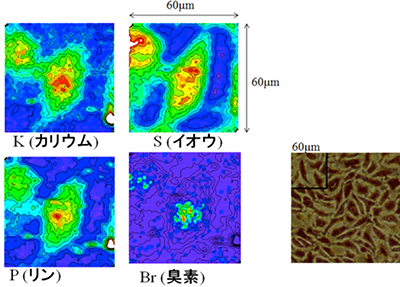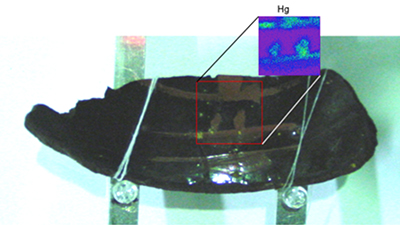Front Line Research
Particle beam analysis holds a promising range of applications in fields such as medicine, engineering, biology and archeology.
We are pursuing research and development in advanced analysis technologies utilizing particle beams.
When charged particles generated by an accelerator collide with a specimen, x-rays particular to that material are emitted. Through this, PIXE is the technology that can easily analyze elements from sodium to uranium contained in specimens without destroying them at sensitivities higher than parts per million. This laboratory is involved in the research and development of advanced engineering utilizing particle beams, including microPIXE cameras that can render intracellular elemental analysis as images, and micron CT that can capture CT images of cells.
Particle beams are used in elemental analysis and new materials, and in the creation of functional materials. But particle beams are also used in a wide range of applications in various fields such as engineering, the environment, medicine, archeology and others.
We aim for even higher spatial resolution, from the micro level to the nano level.
What can be seen through optical microscopes and particle beams are totally different. In contrast with optical microscopes that allow us to see the shape of materials and cells as they are, particle beams allow us to see elemental distribution; in other words, we can see things we can't see with the naked eye.
Up until about 40 years ago, we just exposed an object to a particle beam and analyzed that. Nowadays, we can manipulate a beam, and through this we have been able to obtain elemental spatial distribution and capture that as an image. In addition, by scanning micro beams on a material's surface, we have been able to obtain images of a micro region's elemental distribution at a micro region of 60 µm x 60 µm (1 µm is equivalent to 1/1000 mm). Based on this principle, analyzers utilizing microPIXE cameras now aim for high precision at the nano level.
Under the helm of Associate Professor Matsuyama, who leads micro beam research worldwide, this laboratory pursues research into micro beams, nano beams and their technological development. Our main research subjects are the following: the technological development of a particle beam's refinement from the micro level to the nano level, the development and applications of micro-PIXE and micron CT, as well as the development of material processing techniques, applications of Submilli-PIXE cameras in medicine, biology, environmental science and archeology, and the advancement of radiation measurement technologies which are the fundamental technologies of quantum energy engineering and their applications in nuclear energy, global environmental remediation and medical technology.




